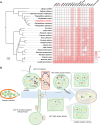A modified Agrobacterium-mediated transformation for two oomycete pathogens
- PMID: 37083862
- PMCID: PMC10156060
- DOI: 10.1371/journal.ppat.1011346
A modified Agrobacterium-mediated transformation for two oomycete pathogens
Abstract
Oomycetes are a group of filamentous microorganisms that include some of the biggest threats to food security and natural ecosystems. However, much of the molecular basis of the pathogenesis and the development in these organisms remains to be learned, largely due to shortage of efficient genetic manipulation methods. In this study, we developed modified transformation methods for two important oomycete species, Phytophthora infestans and Plasmopara viticola, that bring destructive damage in agricultural production. As part of the study, we established an improved Agrobacterium-mediated transformation (AMT) method by prokaryotic expression in Agrobacterium tumefaciens of AtVIP1 (VirE2-interacting protein 1), an Arabidopsis bZIP gene required for AMT but absent in oomycetes genomes. Using the new method, we achieved an increment in transformation efficiency in two P. infestans strains. We further obtained a positive GFP transformant of P. viticola using the modified AMT method. By combining this method with the CRISPR/Cas12a genome editing system, we successfully performed targeted mutagenesis and generated loss-of-function mutations in two P. infestans genes. We edited a MADS-box transcription factor-encoding gene and found that a homozygous mutation in MADS-box results in poor sporulation and significantly reduced virulence. Meanwhile, a single-copy avirulence effector-encoding gene Avr8 in P. infestans was targeted and the edited transformants were virulent on potato carrying the cognate resistance gene R8, suggesting that loss of Avr8 led to successful evasion of the host immune response by the pathogen. In summary, this study reports on a modified genetic transformation and genome editing system, providing a potential tool for accelerating molecular genetic studies not only in oomycetes, but also other microorganisms.
Copyright: © 2023 Wang et al. This is an open access article distributed under the terms of the Creative Commons Attribution License, which permits unrestricted use, distribution, and reproduction in any medium, provided the original author and source are credited.
Conflict of interest statement
The authors have declared that no competing interests exist.
Figures






Similar articles
-
Establishment of a simple and efficient Agrobacterium-mediated transformation system for Phytophthora palmivora.BMC Microbiol. 2016 Sep 6;16(1):204. doi: 10.1186/s12866-016-0825-1. BMC Microbiol. 2016. PMID: 27599726 Free PMC article.
-
Agrobacterium tumefaciens mediated transformation of the oomycete plant pathogen Phytophthora infestans.Mol Plant Pathol. 2003 Nov 1;4(6):459-67. doi: 10.1046/j.1364-3703.2003.00191.x. Mol Plant Pathol. 2003. PMID: 20569405
-
A Cas12a-based gene editing system for Phytophthora infestans reveals monoallelic expression of an elicitor.Mol Plant Pathol. 2021 Jun;22(6):737-752. doi: 10.1111/mpp.13051. Epub 2021 Mar 16. Mol Plant Pathol. 2021. PMID: 33724663 Free PMC article.
-
Agrobacterium-Mediated Transformation of Yeast and Fungi.Curr Top Microbiol Immunol. 2018;418:349-374. doi: 10.1007/82_2018_90. Curr Top Microbiol Immunol. 2018. PMID: 29770864
-
Recent advances in oomycete genomics.Adv Genet. 2020;105:175-228. doi: 10.1016/bs.adgen.2020.03.001. Epub 2020 Apr 25. Adv Genet. 2020. PMID: 32560787 Review.
Cited by
-
Revealing real-time 3D in vivo pathogen dynamics in plants by label-free optical coherence tomography.Nat Commun. 2024 Sep 27;15(1):8353. doi: 10.1038/s41467-024-52594-x. Nat Commun. 2024. PMID: 39333465 Free PMC article.
-
Viable protoplast isolation, organelle visualization and transformation of the globally distributed plant pathogen Phytophthora cinnamomi.Protoplasma. 2024 Sep;261(5):1073-1092. doi: 10.1007/s00709-024-01953-y. Epub 2024 May 4. Protoplasma. 2024. PMID: 38702562 Free PMC article.
-
Bioluminescent imaging of an oomycete pathogen empowers chemical selections and rational fungicide applications.Plant Methods. 2025 May 7;21(1):57. doi: 10.1186/s13007-025-01374-9. Plant Methods. 2025. PMID: 40336036 Free PMC article.
-
Transient expression of fluorescent proteins and Cas nucleases in Phytophthora agathidicida via PEG-mediated protoplast transformation.Microbiology (Reading). 2025 Mar;171(3):001547. doi: 10.1099/mic.0.001547. Microbiology (Reading). 2025. PMID: 40153308 Free PMC article.
References
-
- Dubresson R, Kravchuk Z, Neuhaus J-M, Mauch-Mani B. Optimisation and comparison of transient expression methods to express the green fluorescent protein in the obligate biotrophic oomycete Plasmopara viticola. Vitis. 2008;47(4):235–40.
Publication types
MeSH terms
LinkOut - more resources
Full Text Sources
Research Materials

